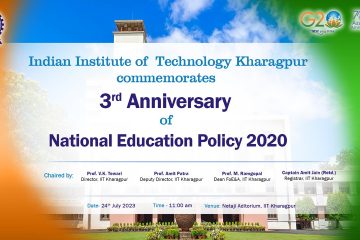IIT Kharagpur Develops Robotic Solution for Plant Disease Identification and Pesticide Use

India is moving at an accelerated pace towards digitization automation. The farm sector which employs about 58% of India’s workforce and contributes to about 14% of the current GDP, has adopted technological advancement to warrant uniform progress. However, farm mechanization in India still has less than 50% penetration. The Govt of India has been taking several measures and a significant drive towards this end is the multi-body project “Development of autonomous multipurpose agricultural robotic platform” funded by the Ministry of Electronics and Information Technology and run by C-DAC Kolkata as the nodal implementing institute along with IIT Kharagpur, BAU Ranchi and KCT Coimbatore. Under this project, IIT Kharagpur has designed a robotic system capable of identifying the plant diseases (say vegetables, maize etc.) through the camera-captured image analysis and spraying the appropriate pesticide, as the situation demands.
The robotic system is a tracked mobile manipulator that aims to achieve the conflicting objectives of increased productivity, improved quality. This robotic system consists of (i) a tracked vehicle suitable for negotiating rough terrain field, (ii) a serial manipulator mounted on the tracked vehicle capable of holding the camera and pesticide spraying nozzle, (iii) a pesticide spraying module, and (iv) camera-based vision module.
Prof. D K Pratihar, from the Dept. of Mechanical Engineering who is leading this innovative project said, “Our device can detect the plant diseases using camera and image analysis thus model the uncertainty associated with the human vision system and consequently remove it. This will help the farmers to detect the disease(s) correctly. Further use of such a device instead of manual operation of spraying pesticide will protect the farmers from related probable health hazards.”
The device has been fabricated by Sun Fab Industries Pvt. Limited, Mumbai (in collaboration with TECHNIDO).
“The serial manipulator will have sufficient dexterous workspace making it capable of spraying the pesticides from the top, bottom and various sides of the plant, which may be difficult to achieve utilizing the widely used drones,” said Prof. Alok Kanti Deb from the Dept of Electrical Engineering.
The developed robotic system is battery-driven one and once it is fully charged, it will be able to perform its duty in the field for about two hours. The robot will be operated remotely using buttons placed on a control panel and thus, a specialist technician may not be required for operating the robot in the field.
“We will soon resume the final assembly of the robotic system and field testing as we are recovering from the present COVID-situation. We have further plans in the future to make this robot autonomous and intelligent,” confirmed Prof. Pratihar.
The Government of India is giving a major boost to innovative rural livelihood technologies. In May 2020, the Finance Ministry had announced an economic stimulus of ₹1.5 trillion to boost agricultural infrastructure and logistics.
Talking about the potential of such technologies Director, Prof. V K Tewari, who himself is an expert in farm machinery design and precision agriculture said, “If we are looking at a comprehensive development towards Atmanirbhar Bharat, the strategic importance of such technology development is profound. Most importantly such technologies need to be taken from the lab to the land.”
Media Coverage:
| Hindustan Times | News18 | Careers 360 |
| Dainik Jagran | NDTV Khabar | Millennium Post |
| The Week | Outlook | ABP Education |
| Zee Business |
Project Contact: Prof. D K Pratihar, dkpra@mech.iitkgp.ac.in
Media Contact: Shreyoshi Ghosh, E: shreyoshi@adm.iitkgp.ac.in; M: +91 8145 736 048
For News Visit: https://kgpchronicle.iitkgp.ac.in/
Follow IIT Kharagpur on Social Media: Facebook: @IIT.Kgp; Twitter: @IITKgp; Instagram: @iit.kgp



